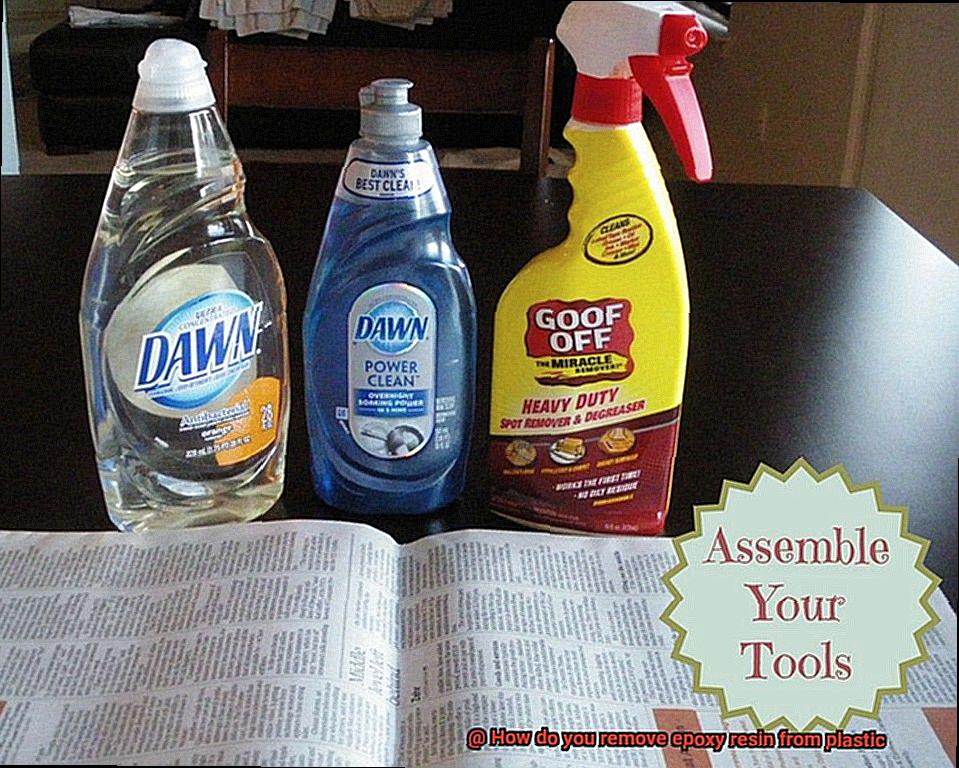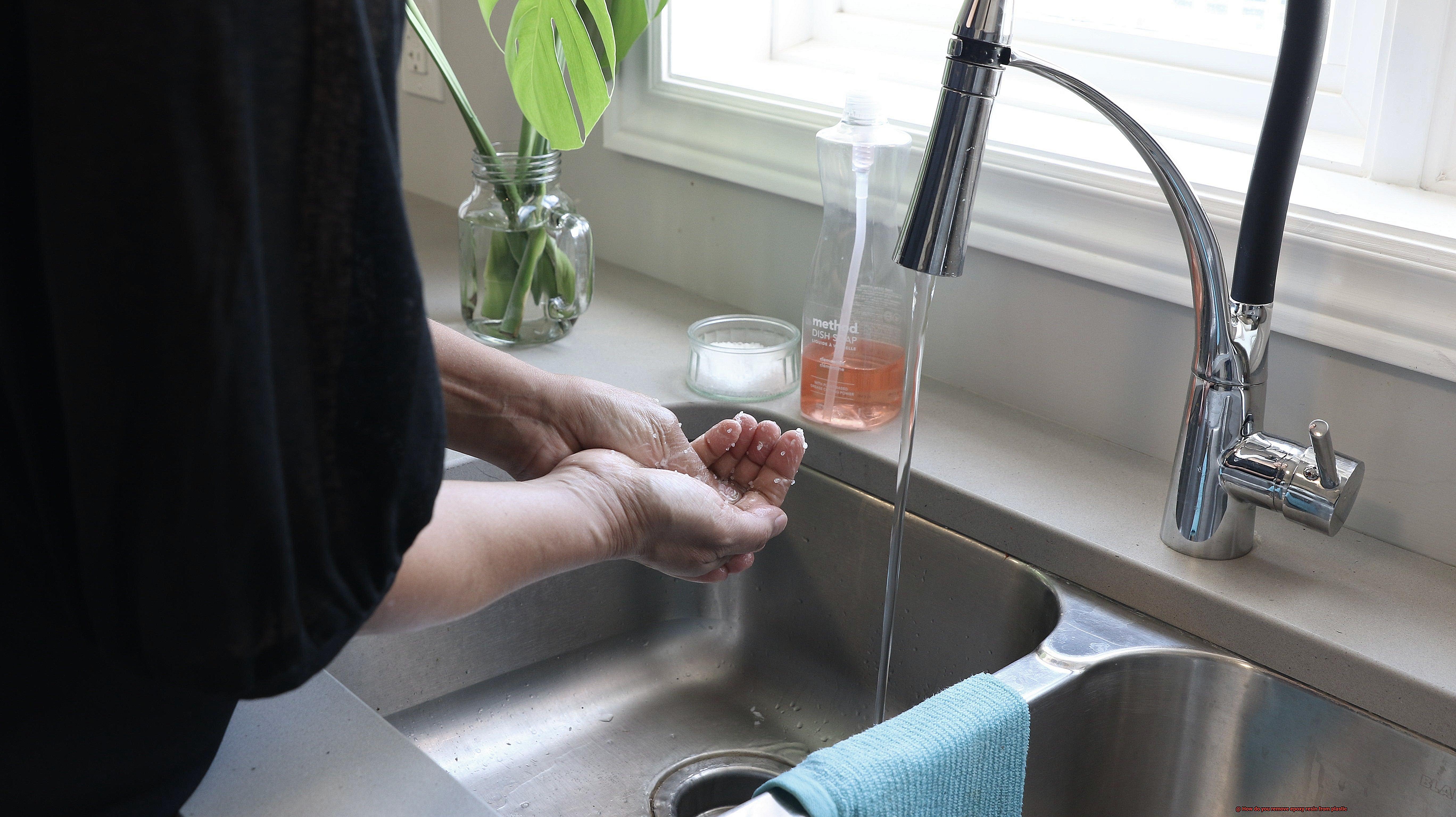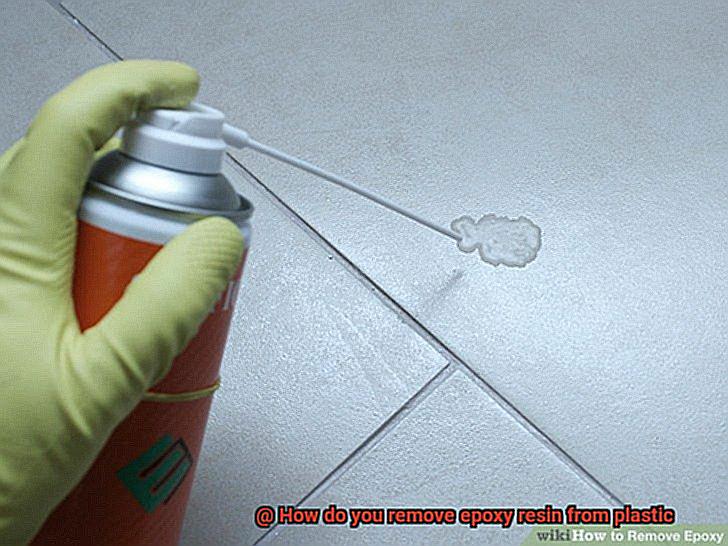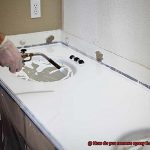Do you love to create and experiment with epoxy resin in your DIY projects? But what happens when you accidentally spill or drip it onto your plastic surface? Fear not. Removing epoxy resin from plastic may seem like a daunting task, but we’ve got you covered.
Epoxy resin is a versatile and durable material that can be used for various applications. However, once it’s cured, it can be challenging to remove. If it sticks to a plastic surface, it can ruin the appearance and shorten its lifespan. That’s why knowing how to remove it is crucial.

In this blog post, we’ll provide you with valuable insights on how to remove epoxy resin from plastic surfaces. We’ll explore different methods such as using solvents, heat, and mechanical means. We’ll explain the pros and cons of each method and share safety precautions to take when using them.
With this information at your fingertips, unsightly epoxy resin stains on your plastic surfaces will be a thing of the past. You’ll gain the confidence and knowledge to tackle any epoxy resin mishaps and maintain the beauty of your plastic surfaces. So let’s dive in together and learn how to remove epoxy resin from plastic.
Identifying the Type of Plastic
Contents
Removing epoxy resin from plastic surfaces can be a tricky process, especially if you don’t know the type of plastic you’re dealing with. Different types of plastics require different removal methods, and using the wrong one can cause irreparable damage. So, how do you identify the type of plastic and choose the right removal method?
There are various ways to identify the type of plastic used in everyday objects. The easiest method is to look for recycling codes on the bottom or side of the plastic object. These codes range from 1-7 and indicate the type of plastic used. For instance, polyethylene (PE) has a code of 2, while polypropylene (PP) has a code of These codes can provide valuable information about the material and guide your removal method.
However, not all plastics have recycling codes, and in these cases, you can use the burn test. This test involves burning a small piece of the plastic and observing how it burns and smells. Each type of plastic has its unique characteristics when burned, which can help identify it. For example, PE will drip and smell like wax, while PVC will produce black smoke and a strong chemical smell.
Once you’ve identified the type of plastic, you can choose the appropriate removal method. Here are some common types of plastics used in everyday objects:
- Polyethylene (PE): rubbing alcohol or acetone can be used to dissolve epoxy resin.
- Polypropylene (PP): similar to PE, rubbing alcohol or acetone works well for removing epoxy resin.
- Polyvinyl chloride (PVC): requires a solvent such as methyl ethyl ketone (MEK) to break down the epoxy resin.
- Polystyrene (PS): more challenging to remove epoxy resin from, so mechanical methods such as sanding or scraping may be necessary.
- Acrylonitrile butadiene styrene (ABS): also difficult to remove epoxy resin from, so mechanical methods such as sanding or scraping may be necessary.
It’s essential to test the removal method on a small, inconspicuous area first to ensure that it doesn’t damage or discolor the plastic surface. When using solvents or heat guns, it’s crucial to use protective gear such as gloves and eyewear to avoid any harm.
Heat Gun or Hairdryer Method

This popular technique involves using either a heat gun or hairdryer to gently warm up the epoxy resin, making it soft and pliable for easy removal.
Of course, safety should always be your top priority. Both heat guns and hairdryers can reach high temperatures, so it’s essential to wear protective gloves and eyewear while working with them. Furthermore, keep the heat source at a safe distance from the plastic surface to avoid any damage.
Once you’re ready to begin, turn on your heat source and point it at the epoxy resin on the plastic surface. Remember to move it back and forth over the area, never staying in one spot for too long. The key here is to gently warm up the epoxy resin without causing any harm to the plastic underneath.
After a few minutes, you should notice the epoxy resin becoming soft and pliable. At this point, use a plastic scraper or credit card to gently peel off the softened epoxy resin. If any residue remains, repeat the process until all of the epoxy resin has been removed.
It’s worth noting that this method is effective not just for removing epoxy resin from plastic surfaces, but also from other materials like wood or metal. With proper care and attention, this method can be a game-changer for all your adhesive removal needs.
Solvent Method
If you’re facing the challenge of removing epoxy resin from plastic, don’t despair. The solvent method is a popular and effective solution. As an expert in this field, I’ve compiled some research notes and crafted a step-by-step guide to help you execute this method like a pro.
To start with, gather your supplies. You’ll need a chemical solvent such as acetone, rubbing alcohol, or lacquer thinner. Acetone is the most commonly used solvent and can be easily found at most hardware stores. You’ll also require a clean cloth or cotton ball, and a scraper or credit card.
Before you begin, it’s essential to prioritize safety. Wear gloves and work in a well-ventilated area as solvents can be hazardous if inhaled or come into contact with skin.
Now that you’ve taken precautions, apply the solvent onto a clean cloth or cotton ball and rub it onto the affected area. Allow it to sit for a few minutes to dissolve the epoxy resin. You’ll notice the resin starting to soften.
Once the epoxy resin has softened, gently scrape it off from the plastic using a scraper or credit card. Avoid applying too much pressure as this can scratch or damage the plastic. If necessary, repeat this process several times until all of the epoxy resin has been removed.
After all of the epoxy resin has been removed, clean the area thoroughly with soap and water to remove any remaining solvent residue.
Sanding Method
Removing epoxy resin from plastic can be a daunting task, but fear not, as sanding is an effective method that can help you restore your plastic to its former glory. However, this method requires caution and attention to detail to ensure that you don’t damage the plastic.
To get started, gather your supplies, including sandpaper, a sanding block, gloves, and goggles for safety. Identify the areas where the epoxy resin needs to be removed and mark them to keep track of your progress.
Begin sanding with a coarse grit (60-80) sandpaper in a circular motion. Be sure not to apply too much pressure as it can cause scratches or damage the plastic. Take your time and be patient as this is a meticulous process.
Once you have removed most of the resin with coarse grit sandpaper, switch to a finer grit (120-220) sandpaper. Continue sanding with a circular motion until all of the resin has been removed. Remember to take breaks in between and check your progress to ensure that you are not over-sanding or damaging the plastic.
After removing all of the resin, clean the plastic surface thoroughly with soap and water to remove any remaining debris or particles. Dry the surface completely before moving on to any further steps.

In summary, sanding can effectively remove epoxy resin from plastic surfaces, but it requires proper technique and safety gear. Always exercise caution when sanding and take breaks to prevent over-sanding or damaging the plastic surface.
Safety Tips for Removing Epoxy Resin from Plastic
Removing epoxy resin from plastic can be a challenging task, but it’s important to prioritize safety at all times. Here are five key tips and precautions to keep in mind when removing epoxy resin from plastic:
Protective Gear
Always wear protective gloves and eyewear when handling epoxy resin. This is essential to prevent any skin or eye irritation that could result from contact with the chemical. In addition, it’s also important to wear a respirator mask to protect against fumes.
Ventilation
Work in a well-ventilated area to avoid inhaling any fumes from the resin. This means opening windows and doors, or using a fan or ventilation system to ensure proper air flow.
Identify the Plastic
Before attempting to remove the epoxy resin, it’s critical to identify the type of plastic it is adhered to. Different types of plastics may have different reactions to certain solvents or chemicals used in the removal process. If you’re unsure about the type of plastic, it’s best to consult with the manufacturer or a professional.
Safe Solvents
When selecting a solvent or chemical for removing epoxy resin from plastic, it’s important to choose one that is safe for both the plastic and the user. Acetone is a common solvent used for removing epoxy resin, but it can also dissolve certain types of plastic. Alcohol or vinegar solutions may be safer alternatives, but may require more time and effort for effective removal.
Follow Instructions
Once you have selected a solvent or chemical, it’s essential to follow the instructions carefully and apply it only to the area where the epoxy resin is located. Avoid applying too much pressure or using abrasive tools as this can damage the plastic surface. It’s also important to wear gloves and use a brush or cloth for application.
In addition to these five key tips, it’s also important to properly dispose of any chemicals or solvents used for removal. Do not pour them down the drain or dispose of them in a trash can. Instead, check with your local hazardous waste disposal facility for proper disposal methods.
Pros and Cons of Different Removal Methods
Removing epoxy resin from plastic can be a tricky task, but with the right method, it can be done efficiently and safely. There are several methods that you can use to remove epoxy resin from plastic, each with its own set of pros and cons. The choice of which method to use will depend on various factors such as the type of plastic, the amount of epoxy resin to be removed, and the desired outcome.
One popular method for removing epoxy resin from plastic is using a heat gun or hairdryer. This method involves heating the epoxy resin until it becomes soft and pliable, making it easier to peel off from the plastic surface. The advantage of this method is that it doesn’t require any special tools or chemicals, and it’s relatively easy to do. However, it can be time-consuming and may not work well if the epoxy resin is thick or has hardened.
Another method that you can use is using a chemical solvent such as acetone or rubbing alcohol. These solvents dissolve the epoxy resin, making it easy to wipe or scrape off from the plastic surface.
The advantage of this method is that it’s fast and efficient, especially for small amounts of epoxy resin. However, some solvents may damage certain types of plastic or cause discoloration, so it’s important to test them on a small area first.
If you prefer mechanical methods, sanding or scraping might be your best option. This method involves using abrasive materials such as sandpaper or a razor blade to physically remove the epoxy resin from the surface. It’s effective for large amounts of epoxy resin and doesn’t require any chemicals. However, it can be messy and may result in scratches or damage to the plastic surface.
When choosing which method to use, consider these sub-topics:
- Safety: Always protect yourself when removing epoxy resin by wearing protective gear like gloves and goggles.
- Type of Plastic: Different types of plastic may react differently to heat, solvents, or abrasives. Make sure to research which method is safe to use on your specific type of plastic.
- Amount of Epoxy Resin: If you’re dealing with a small amount of epoxy resin, a chemical solvent might be the most efficient method. If you have a larger amount of epoxy resin, mechanical methods may be more effective.
Troubleshooting Common Issues with Epoxy Resin Removal
Removing epoxy resin from plastic surfaces can be a daunting task, but with the right approach, it can be a smooth and successful process. However, there are some common issues that people may encounter when attempting to remove epoxy resin. Here are some troubleshooting tips to help you overcome those obstacles.
Sticky residue is one of the most common problems people face when removing epoxy resin from plastic surfaces. Incomplete removal or incorrect application of the removal agent can leave behind a stubborn residue that is challenging to remove. To avoid this issue, it’s important to choose a removal agent that is suitable for your specific type of plastic and follow the instructions carefully.
Another potential issue is possible damage to the plastic surface during the removal process. Some plastics are more delicate than others and can scratch or discolor if not handled properly. To prevent this, it’s crucial to take proper precautions before and during the removal process. For instance, select a removal agent that is gentle on your plastic type, and use tools that are appropriate for small or hard-to-reach areas.
In addition, removing epoxy resin from corners or crevices can pose challenges. Specialized tools or techniques may be necessary to ensure complete removal without damaging the plastic surface. Be sure to have patience in these areas and methodically work through each corner and crevice.
MPvteGZYsjg” >
Conclusion
In conclusion, don’t let the thought of removing epoxy resin from plastic surfaces intimidate you. With a little know-how and the right tools, you can easily tackle this task without causing damage to your precious plastic items. It’s essential to identify the type of plastic before choosing a removal method that suits it best.
Whether you opt for a solvent method, heat gun or hairdryer method, or sanding method, each approach has its advantages and disadvantages. Safety should always be a top priority when working with chemicals and high temperatures. So make sure to wear protective gear and work in a well-ventilated area.
Encountering sticky residue or potential damage during the removal process is common but not insurmountable. Troubleshooting tips are available to help overcome these challenges with ease. Patience and attention to detail are key ingredients in successfully removing epoxy resin from plastic surfaces.
By following the tips and techniques outlined in this article, you’ll become an expert at tackling any epoxy resin mishaps that may occur during your DIY projects.






